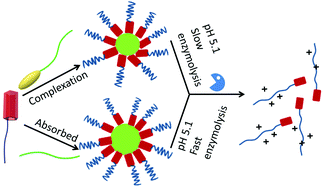当前位置:
X-MOL 学术
›
Polym. Chem.
›
论文详情
Our official English website, www.x-mol.net, welcomes your
feedback! (Note: you will need to create a separate account there.)
Degradable polycaprolactone nanoparticles stabilized via supramolecular host–guest interactions with pH-responsive polymer-pillar[5]arene conjugates
Polymer Chemistry ( IF 4.1 ) Pub Date : 2020/02/28 , DOI: 10.1039/c9py01928f Peng Wei 1, 2, 3, 4, 5 , Fabian H. Sobotta 1, 2, 3, 4, 5 , Carolin Kellner 1, 2, 3, 4, 5 , Damiano Bandelli 1, 2, 3, 4, 5 , Stephanie Hoeppener 1, 2, 3, 4, 5 , Stephanie Schubert 2, 3, 4, 5, 6 , Johannes C. Brendel 1, 2, 3, 4, 5 , Ulrich S. Schubert 1, 2, 3, 4, 5
Polymer Chemistry ( IF 4.1 ) Pub Date : 2020/02/28 , DOI: 10.1039/c9py01928f Peng Wei 1, 2, 3, 4, 5 , Fabian H. Sobotta 1, 2, 3, 4, 5 , Carolin Kellner 1, 2, 3, 4, 5 , Damiano Bandelli 1, 2, 3, 4, 5 , Stephanie Hoeppener 1, 2, 3, 4, 5 , Stephanie Schubert 2, 3, 4, 5, 6 , Johannes C. Brendel 1, 2, 3, 4, 5 , Ulrich S. Schubert 1, 2, 3, 4, 5
Affiliation

|
Smart nano-carriers such as micelles, vesicles or nanoparticles constructed from amphiphilic polymers promise a new generation of drug delivery systems featuring localized and controlled release. Keeping the considerable effort for the synthesis of these polymers in mind, supramolecular host–guest interactions represent an interesting alternative to engineer amphiphilic materials with multiple functionalities. Using the known interaction of pillar[5]arenes with aromatic guests such as viologen-derivatives, we designed quasi-block copolymers based on polycaprolactone (PCL) and either the neutral and biocompatible poly(N-acryloyl morpholine) (PNAM-P[5]) or the structurally similar but pH-responsive poly(N-acryloyl-N′-methyl piperazine) (PNAMP-P[5]), which were modified with the pillar[5]arene. Self-assembly experiments in water resulted in the formation of small spherical nanostructures for the methyl viologen-polycaprolactone (viologen-PCL), but surprisingly also for the non-functionalized PCL. However, only the pH-responsive PNAMP-P[5] provided stable structures in the buffer for both cases, while PNAM-P[5] resulted in aggregation. Additional degradation studies revealed that the presence of host–guest complexes could retard the disintegration of the particles at low pH (5.1) in comparison to the particles based on plain PCL, while all structures remained stable at neutral pH value. In combination with their excellent biocompatibility, the presented supramolecular approach to stabilize PCL nanoparticles with pH-responsive polymers pave a convenient way to degradable delivery systems with tailored release profiles.
中文翻译:

可降解的聚己内酯纳米颗粒通过超分子主客体与pH响应聚合物-桩[5]芳烃偶联物的相互作用而稳定
由两亲性聚合物构成的智能纳米载体,如胶束,囊泡或纳米颗粒,有望实现具有局部和控释功能的新一代药物递送系统。考虑到合成这些聚合物的巨大努力,超分子主体与客体的相互作用代表了一种工程化具有多种功能的两亲材料的有趣替代方法。利用已知的支柱[5]芳烃与芳族客体(如紫精衍生物)的相互作用,我们设计了基于聚己内酯(PCL)和中性和生物相容性聚(N-丙烯酰基吗啉)(PNAM-P [5]的准嵌段共聚物])或结构相似但对pH敏感的聚(N-丙烯酰基-N'[-甲基哌嗪](PNAMP-P [5]),已通过柱[5]芳烃改性。水中的自组装实验导致甲基紫精-聚己内酯(viologen-PCL)形成了小的球形纳米结构,但令人惊讶的是,未官能化的PCL也形成了球形的纳米结构。然而,在两种情况下,只有pH响应型PNAMP-P [5]在缓冲液中提供稳定的结构,而PNAM-P [5]导致聚集。进一步的降解研究表明,与基于普通PCL的颗粒相比,在低pH(5.1)下宿主-客体复合物的存在可能会阻碍颗粒的崩解,而所有结构在中性pH值下均保持稳定。结合其出色的生物相容性,
更新日期:2020-03-24
中文翻译:

可降解的聚己内酯纳米颗粒通过超分子主客体与pH响应聚合物-桩[5]芳烃偶联物的相互作用而稳定
由两亲性聚合物构成的智能纳米载体,如胶束,囊泡或纳米颗粒,有望实现具有局部和控释功能的新一代药物递送系统。考虑到合成这些聚合物的巨大努力,超分子主体与客体的相互作用代表了一种工程化具有多种功能的两亲材料的有趣替代方法。利用已知的支柱[5]芳烃与芳族客体(如紫精衍生物)的相互作用,我们设计了基于聚己内酯(PCL)和中性和生物相容性聚(N-丙烯酰基吗啉)(PNAM-P [5]的准嵌段共聚物])或结构相似但对pH敏感的聚(N-丙烯酰基-N'[-甲基哌嗪](PNAMP-P [5]),已通过柱[5]芳烃改性。水中的自组装实验导致甲基紫精-聚己内酯(viologen-PCL)形成了小的球形纳米结构,但令人惊讶的是,未官能化的PCL也形成了球形的纳米结构。然而,在两种情况下,只有pH响应型PNAMP-P [5]在缓冲液中提供稳定的结构,而PNAM-P [5]导致聚集。进一步的降解研究表明,与基于普通PCL的颗粒相比,在低pH(5.1)下宿主-客体复合物的存在可能会阻碍颗粒的崩解,而所有结构在中性pH值下均保持稳定。结合其出色的生物相容性,











































 京公网安备 11010802027423号
京公网安备 11010802027423号